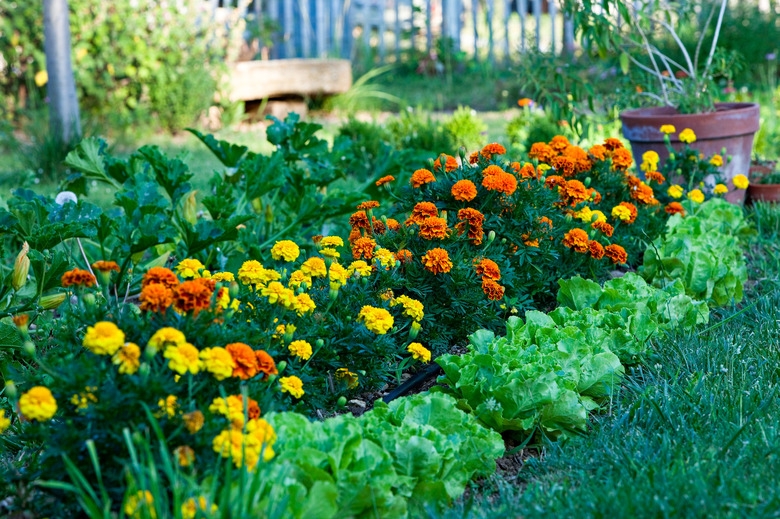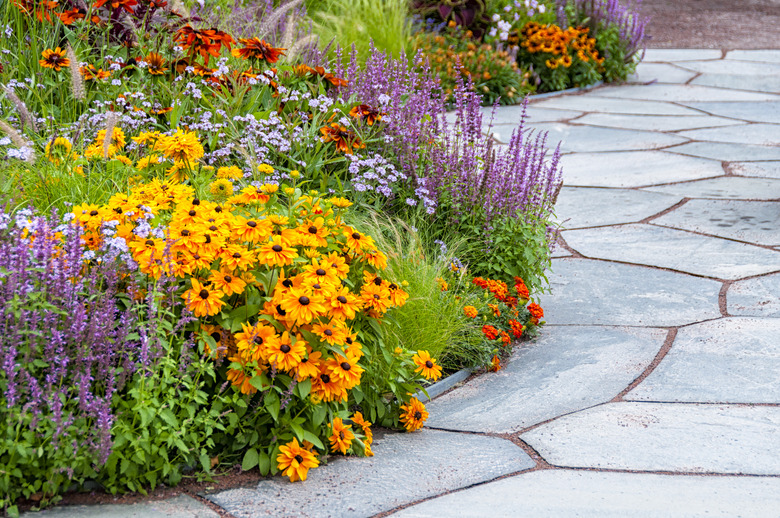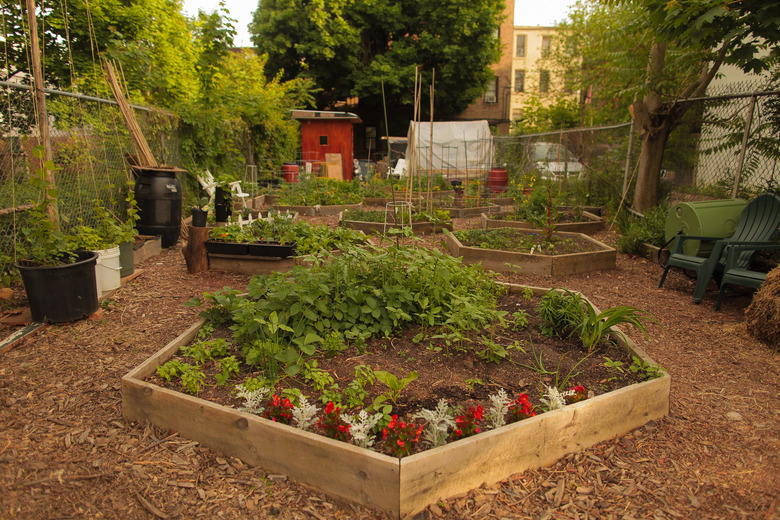Fertilizing Your Vegetable Or Flower Garden
We may receive a commission on purchases made from links.
Fertilizing your garden seems like a no-brainer, but it's a little more complicated than just spreading some store-bought granules on your vegetables and flowers and watching them mature into blue-ribbon specimens. Too much fertilizer or the wrong kind can do more harm than good, as can the right kind of fertilizer applied at the wrong time. The right kind of fertilizer applied at the right time and in the right amount, however, can indeed make your garden bloom and fill your table with fresh, tasty produce.
The first step in determining the right fertilizer is to get a soil test because that will tell you which nutrients are present and which are missing. If all the essential nutrients are already there, you don't need to fertilize, and it's actually better that you don't. It's a little bit like overeating: The extra nutrients go to places in your body where you don't want them and end up turning your svelte figure into one that's not so svelte, and so it is with the plants in your garden. Their leaves can get too large relative to the flowers and vegetables or vice versa — the blooms can be too dominant.
To get a handle on the fertilizing needs of your garden, it's important to know what fertilizers do. They augment the soil with the basic nutrients that a plant needs for healthy growth, and depending on the composition of the specific fertilizer you use, they can help plants develop healthy foliage, roots and stalks and also help the plants resist disease. Whether you get quick results from a fertilizer or more long-term benefits depends on the type you use, whether it's organic or inorganic and granule or liquid form or simply a natural material, such as compost, manure or decomposed leaves that you turn into the soil.
N-P-K, the Three Fertilizing Nutrients
N-P-K, the Three Fertilizing Nutrients
The three nutrients plants need most are nitrogen (N), phosphorous (P) and potassium (K), elements that plants metabolize into life-sustaining compounds as they grow. Nitrogen is the most abundant element in the atmosphere, and plants use it to form amino acids, which ultimately are turned into proteins. Plants need phosphorous for photosynthesis, storage and transfer of energy and respiration, and they need potassium to regulate the exchange of water vapor, oxygen and carbon dioxide as well as for enzyme activation. The common wisdom is that plants need nitrogen for lush green foliage, phosphorous for growth, including strong roots and blooms, and potassium for overall health.
Each commercial fertilizer is formulated with different concentrations of these three nutrients, and their relative concentrations, known as the N-P-K ratio, is displayed on the fertilizer label. A 30-10-10 formulation, for example, contains 30 percent nitrogen, 10 percent phosphorous and 10 percent potassium. The remaining 50 percent of the material is a filler, which may contain nutrients that plants need in smaller quantities, such as calcium, magnesium and sulfur, and may also contain micronutrients that plants need in trace amounts, such as boron, chlorine, sulfur, iron, manganese, molybdenum and zinc.
A complete fertilizer is one that contains all three of the main nutrients in the same proportions — for example, 10-10-10 — and is usually considered an all-purpose fertilizer. You don't always need a complete fertilizer, though. If your vegetable plants have lush green foliage but underdeveloped vegetables, that probably means the soil has too much nitrogen but not enough of the other nutrients, so the garden would be better off with a fertilization formula low in nitrogen, such as 3-20-20.
The Best N-P-K Ratio to Use
The Best N-P-K Ratio to Use
You should always conduct a soil test before you purchase fertilizer for your vegetable or flower garden, which you can do by collecting a soil sample and taking it to a garden center or your local university extension. If the soil is already well-fertilized and contains sufficient levels of the three basic nutrients, you'll actually be hurting the plants by adding more.
On the other hand, you may find the soil particularly deficient in only one element, in which case you'll want to apply a fertilizer that supplies that element. Young plants trying to get established in cold soil need extra phosphorous for root growth and will benefit from a 10-50-10 mixture that supplies it. Otherwise, the best fertilizer is usually a complete one.
Organic fertilizers generally have lower N-P-K numbers than inorganic ones, which means organic fertilizers have lower nutrient concentrations, and because organic fertilizers generally aren't water soluble, these nutrients get released at a slower rate. Far from being a bad thing, it's actually an advantage because there's less likelihood of overfeeding plants when you use organic fertilizers, and the nutrients stay in the soil longer. Inorganic fertilizers generally produce quicker results, but you have to apply them more often.
When conducting a soil test, it's also important to check pH, which is a measure of the soil's acidity or alkalinity. Soil acidity regulates nutrient intake, and if the soil is too acidic, adding more fertilizer won't help because the roots won't be able to absorb the nutrients. Most plants prefer neutral to slightly acidic soil, and some thrive in soil with a pH as low as 5.5. For most plants, though, the pH shouldn't be any lower than 6.0, and if it is, you should turn garden lime into the soil to raise the pH.
Organic and Inorganic Fertilizers
Organic and Inorganic Fertilizers
A good way to characterize the difference between fertilizers is to say that inorganic, or synthetic, fertilizers feed the plants directly, while organic fertilizers feed the soil, and the soil feeds the plants. Synthetic fertilizers are processed from such compounds as ammonia, phosphate-rich mineral deposits and potash, the mining of which yields potassium, and processing is a major source of greenhouse gases. Organic fertilizers occur naturally and don't need processing, so if you were a plant in the garden, the difference would be like the difference between eating processed and organic food.
Synthetic fertilizers come in granular or liquid form, and both are water soluble. While some granular fertilizers have a slow-release coating that delays absorption into the soil, as a rule, synthetic fertilizers dissolve and pass out of the soil quickly, so you usually have to fertilize more than once during the growing season to ensure plants get the nutrients they need. Organic fertilizers don't make as many nutrients available as synthetic ones when you introduce them into the garden soil, but they don't dissolve, so they last for the entire season, and the plants get a feeding every time it rains.
Organic fertilizers come in many forms, including compost, aged manure, fish emulsion and decomposed leaves or other organic material from the garden. With the exception of fish emulsion, which you can spray, and blood or bone meal, which are granulated, most organic materials have to be turned into the soil, and the best time to do this is before planting the garden. You can also side-dress your flowers and vegetables with organic fertilizers to give them extra nutrients during the growing season with fewer concerns about overfertilizing and burning the roots than you have when using synthetic fertilizers.
The Best Time for Fertilizing
The Best Time for Fertilizing
Plants need nutrients most when they are young and growing vigorously, which is early spring in most parts of the country. A good practice is to turn fertilizer — preferably organic fertilizer — into the soil a week or so before you plant to give the fertilizer time to release nutrients.
Fertilizing a second time about two weeks after you plant or sow seeds is recommended to help flowers and vegetables get the growing season off to a good start, but the amount you apply depends on what you're growing. Plants that grow quickly need more fertilizer at this time than others, such as annual corn (Zea mays) and tomatoes (Solanum lycopersicum, USDA zones 10-11), which experience a second growth spurt later in the season. These long-season crops need less fertilizer at planting and a second larger application when the growth spurt occurs in June or July.
Perennial plants usually need two applications of fertilizer per season, and although the best time to fertilize depends on the plant, most benefit from an application in the early spring to encourage growth and a second one in the fall. You should also fertilize to stimulate new growth whenever you cut back a plant. Generally speaking, the faster a plant grows, the more fertilizer it needs, but remember that too much fertilizer is not good for plant health. You should also avoid fertilizing a newly transplanted plant because some of the severed roots can absorb too much nitrogen and burn. It's best to wait two to three weeks for the roots to get established before feeding them.
The characteristics of your growing plants can indicate the need for fertilizer and the type to use. If you're noticing lush foliage with substandard flower or vegetable production, the plant is getting too much nitrogen, so an application of a low-nitrogen mixture, such as 3-20-20, would be in order. If the blooms are out of proportion to the foliage, on the other hand, the plant would benefit from a nitrogen-rich mixture. Absent any problems such as these, a complete 5-5-5 or 10-10-10 mixture is usually best.
How to Apply Fertilizer
How to Apply Fertilizer
One way to apply granular fertilizers is to broadcast the granules throughout the garden, but if you want a more targeted approach, you can also side-dress specific plants or rows of plants. The granules have to dissolve in water to be carried into the soil, so the best time to spread granular fertilizer is just before an expected rain. Failing that, watering is essential immediately after fertilizing. To ensure plants get the nutrients they need, it's a good idea to work the fertilizer 4 to 6 inches into the soil, being careful not to disturb the plants' roots, and water deeply to ensure the fertilizer soaks in.
Liquid fertilizers can be poured or sprayed into the soil surrounding the plants, but it's usually best to spray the plants directly and allow them to absorb the nutrients through their foliage. When applying a liquid fertilizer to dry soil, it's important to water the soil well to avoid having the roots absorb too many nutrients at once and then burning. When spraying liquid fertilizer on the leaves, do it in the early morning or early evening so the plants have a chance to absorb the nutrients before the sun evaporates the water. Always follow the application directions on the fertilizer label to ensure you're applying the correct amount; some liquids can be used as is, while others have to be diluted.
Fertilizing your garden with manure, compost or other organic materials is probably the safest and most efficient way to do it, but to provide maximum benefits to the plants, these materials should be turned into the soil. You can, however, use them to mulch around individual plants and allow rainwater to leach the nutrients into the soil. If you buy commercial organic fertilizer, such as bat guano or chicken manure, follow the application instructions on the label for best results.
References
- Mosaic: The Facts: Nitrogen Fertilizer
- Greenway Biotech: What's the Function of Phosphorus (P) in Plants?
- University of Minnesota Extension: Potassium for Crop Production
- The Old Farmer's Almanac: How to Apply Fertilizers to Your Garden
- Old World Garden Farms: 5 Secrets To Fertilizing Vegetable Plants And Flowers – Grow Big Naturally!
- Wilson Bros Gardens: How To Fertilize Perennial Plants
- Gardener's Supply Company: Fertilizer Basics


